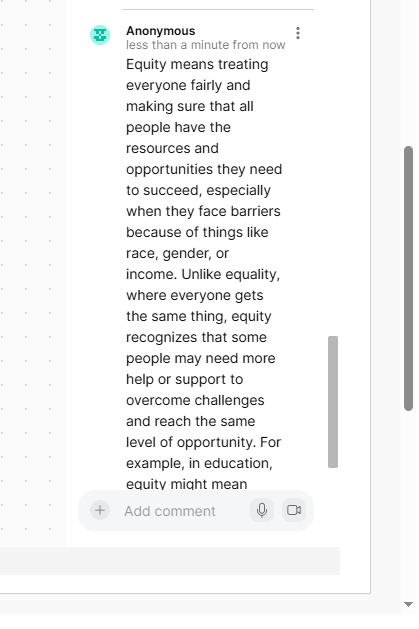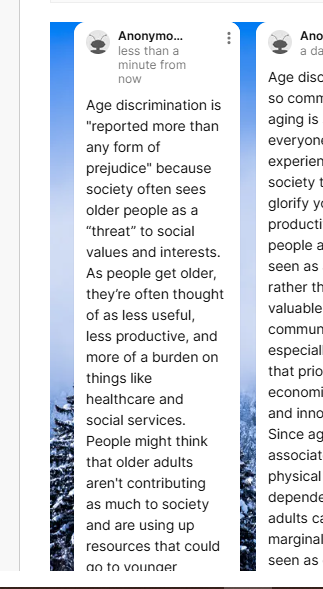6
Section One: The Fundamentals
A) Keywords
Exercise 1:
Provide a brief definition of one of the padlet keywords for this week.

Equity – Equity means treating everyone fairly and making sure that all people have the resources and opportunities they need to succeed, especially when they face barriers because of things like race, gender, or income. Unlike equality, where everyone gets the same thing, equity recognizes that some people may need more help or support to overcome challenges and reach the same level of opportunity. For example, in education, equity might mean giving extra support to students who come from low-income families or face language barriers, so they have the same chances to succeed as other students. The goal of equity is to create fairness by addressing and removing obstacles that might hold certain groups back.
|
B) The Social Significance of Aging in Sport
Exercise 2: Notebook Prompt
How is old age popularly represented today? Find an image online that you think exemplifies one defining attitude towards old age and paste in your notebook below with a brief explanation of what this image means to you.

Old age is often shown in society through stereotypes that influence how we view older people. Many times, older adults are depicted as frail, or out of touch with modern life, especially with technology. This kind of representation can make people afraid of aging and lead to ageism, where older people are treated unfairly or even excluded. These stereotypes can result in older individuals being left out of workplaces, social activities, and other parts of life, as they are seen as less capable or relevant. However, there is a growing movement to change these negative views and show a more positive and realistic picture of aging. This image above is one of the many depicting older people traveling, working, or enjoying hobbies, showing that growing older doesn’t mean slowing down. This new way of representing aging helps to challenge the old stereotypes, showing that aging can be a time for growth and enjoyment. This shift is important because it helps people see old age in a better light, not as something to be feared or avoided, but as a part of life to be celebrated. Changing the way we represent older adults encourages a more inclusive society that values everyone, no matter their age or ability.
|
Exercise 3: Notebook Prompt
What does the article (referencing another study by Dionigi) mean by its statement that sport can help aging people to simultaneously “accept and resist the ageing process” (572)? Respond by audio or text and find paste two images sourced online into your notebook showing how sport might help aging people to both accept and resist the aging process.
 
The statement that sport can help aging people to “accept and resist the aging process” means that sports can play a big role in how older adults experience aging in two ways. First, participating in sports can help older individuals accept the changes that come with getting older. Aging often involves physical changes, like less strength or energy, but sports allow people to acknowledge those changes without feeling defeated. By continuing to be active in sports, they can learn to embrace the natural process of aging and still feel good about staying fit. Second, sports also give older people a way to resist some of the negative effects of aging. Even as the body changes, staying active through sports can help people stay strong, healthy, and independent. Regular exercise can help prevent/delay health issues like muscle loss, joint pain, or problems with balance. By pushing themselves in sports, older adults can fight back against the idea that aging means slowing down or becoming limited in what they can do. |
Exercise 4: Notebook Prompt
Who are the groups less likely to have extensive opportunities to take part in sports, according to Pike? How does privilege factor into aging and sport? (200 words max)
| In Elizabeth Pike’s article “Assessing the Sociology of Sport: On Age and Ability,“ she explains that some groups of people have fewer chances to participate in sports as they get older. This includes people with disabilities, women, and those from lower-income backgrounds. These groups face many challenges that make it harder for them to stay active, such as not having enough money to afford gym memberships or sports equipment, or not having access to places that are designed for their needs. For example, people with disabilities often struggle to find sports activities or locations that are accessible, while women might feel social pressure that stops them from being as active as they would like. Privilege plays an important role in who can participate in sports and who cannot. People with more money, better healthcare, and higher social status usually have more opportunities to stay active and play sports as they age. They can afford to overcome challenges like transportation or finding sports facilities that are suitable for them. On the other hand, people from marginalized groups, like those with lower incomes or disabilities, face more barriers to getting involved in sports. This lack of access to physical activities can create bigger gaps in health and well-being between different groups as they get older.
|
Exercise 5: Padlet Discussion
Why do you think age discrimination is “reported more than any form of prejudice” with older people presented as a threat to social values and interests? Feel welcome to use video in your responses. Paste your comments (or transcript of your video) below!

Age discrimination is “reported more than any form of prejudice” because society often sees older people as a “threat” to social values and interests. As people get older, they’re often thought of as less useful, less productive, and more of a burden on things like healthcare and social services. People might think that older adults aren’t contributing as much to society and are using up resources that could go to younger generations. Older adults are also sometimes seen as stuck in the past, not keeping up with new technology or changes in society. This can make them seem out of touch with what’s happening in the modern world. Because younger people are often seen as full of energy, new ideas, and the ability to keep up with fast changes, while older people are seen as slowing down, this creates negative views about aging. Because age discrimination affects so many areas of life, like work, healthcare, and social activities, it gets reported more. It’s something that everyone can face as they get older, and it affects many people, making it a bigger issue in society compared to other types of prejudice.
|
B) Older Women and Sport
Exercise 6: Notebook Prompt
What differences do you see in these ads? Which one is more inclusive? How is age represented or not represented in each? Answer these questions in your notebook.
| The two ads, “Nike – You Can’t Stop Us (2020)” and “This Girl Can – Me Again,” both promote confidence in sports but in different ways. Nike – You Can’t Stop Us shows athletes from different backgrounds, emphasizing strength and unity, but mostly focuses on younger or professional athletes. The idea of age isn’t really highlighted in this ad. In contrast, This Girl Can – Me Again focuses specifically on older women who are returning to sports after taking time off. It shows that it’s never too late to get active and challenges the stereotype that older women can’t or shouldn’t participate in sports. The ad is much more inclusive because it highlights older women and encourages them to embrace physical activity, no matter their age. Personally, I really like the This Girl Can – Me Again video because it feels empowering and relatable. It shows real women, not just athletes, getting back into exercise in a fun, low-pressure way, which makes it feel more approachable. The focus on older women is refreshing and really breaks down age-related barriers, making the message that anyone can be active, at any age, feel much more real and inspiring. Overall, This Girl Can – Me Again is a great example of inclusivity, showing that fitness is for everyone, no matter how old you are.
|
Exercise 7: Notebook Prompt
In her article, “Assessing the sociology of sport: On age and ability,” Elizabeth Pike references a “trend towards a ‘feminisation of ageing’, with many women living longer than men” (573). Do you agree that aging has been “feminized” in this way? How? Answer these questions in your notebook.
| In her article, “Assessing the Sociology of Sport: On Age and Ability,” Elizabeth Pike talks about how aging has been “feminized,” meaning it’s often associated more with women, especially because women tend to live longer than men. I agree that aging has been “feminized” in some ways. Society often focuses more on how women experience aging, especially in terms of their health, looks, and social roles. An example would be how older women are often shown in media as needing care or being focused on their appearance, while men are less often seen this way. There’s also more pressure on older women to look young and stay active, with society often judging them based on their looks instead of their achievements. Women’s health in older age, especially things like menopause, gets a lot more attention in the healthcare industry, while aging in men isn’t discussed as much. This leads to the idea that aging is something women need to “fix” or worry about more than men, creating extra pressure on older women.
|
Section Three: Module Mini Assignment
Cronk, S. (2023, October 11). Pickleball courts on parking garages? San Francisco weighs new options. SF Chronicle. https://www.sfchronicle.com/sf/article/pickleball-parking-garage-20226702.php Brock, K. (2024, August 22). Florida parks could get pickleball courts, golf courses — and conservationists are worried. WLRN. https://www.wlrn.org/environment/2024-08-22/pickleball-state-parks-golf-florida
|

